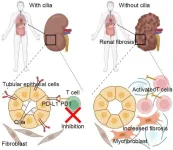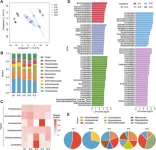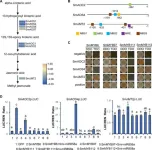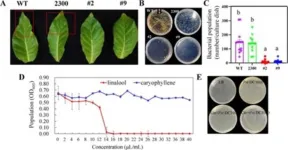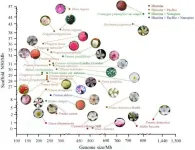(Press-News.org) Ciliopathies are multisystem disorders characterized by the dysfunction of motile and/or non-motile cilia, which show common clinical manifestations of ciliopathies include retinal degeneration, mental retardation, renal abnormality, obesity, and skeletal dysplasia. Fibrosis of vital organs, characterized by the extensive deposition of extracellular matrix components, represents another complication frequently observed in patients and animal models of ciliopathies. However, the precise mechanism that connects ciliary defects to fibrosis remains largely elusive.
The recent study led by Dr. Min Liu (Haihe Laboratory of Cell Ecosystem) and Dr. Yunfan Yang (Shandong University) showed a role for autoinflammation in the onset of ciliopathies. They found that T cell infiltration and attenuated expression of PD-L1 in ciliopathic tissues. Loss of cilia in epithelial cells downregulates PD-L1 and leads to T cell activation.
The initiation and progression of fibrosis are substantially influenced by the infiltration of immune cells, including T cells. Indeed, immune cell infiltration and inflammation can be observed in cilium-deficient fibrotic liver and kidney of ciliopathic patients and animal models. In mouse models of renal fibrosis, the expression of major histocompatibility complex class II (MHCII) is enhanced in renal tubular epithelial cells (RTECs), leading to the proliferation of CD4+ T cells and the pathogenesis of renal fibrosis. It remains to be verified whether the fibrotic phenotype in ciliopathies is a consequence of excessive immune responses caused by cilium deficiency, which may establish a role for autoinflammation in the development of ciliopathies. The connection between ciliopathies and the immune system has been largely overlooked due to the absence of cilia on immune cells. Recently, it has been reported that certain ciliopathic patients have an elevated susceptibility to autoimmune diseases, suggesting that cilia may play a role in immune tolerance.
To determine a potential effect of cilium deficiency on autoimmune response, Tian et al. generated conditional knockout (KO) mice of intraflagellar protein 88 (IFT88), which is a key ciliary protein and loss of which is embryonic lethal in mice, by injecting Ift88flox/flox; Ubc-Cre/ERT2 mice with tamoxifen. They found that IFT88-KO mice, but not WT mice, displayed fibrosis in the kidney and liver at an advanced age. Furthermore, an enhanced infiltration of CD4+ and CD8+ T cells was observed in the fibrotic tissues of IFT88-KO mice, as well as enhanced renal T cell activation. Notably, T cell infiltration was detected prior to the progression of fibrosis, supporting a role for T cell infiltration in the development of fibrosis. A significant reduction in PD-L1 expression and surface manifestation was detected in IFT88-KO mice in comparison to WT mice. Furthermore, the protein level of PD-L1 was also decreased in the kidney, liver, and lung of IFT88-KO mice.
At the cellular level, they found that RTECs, which constitute the major cilium-containing cell type in the kidney, expressed PD-L1 at the highest level. Loss of IFT88 in mRTECs (an immortalized murine cell line of RTECs) disrupted primary cilia and downregulated PD-L1 at both mRNA and protein levels, suggesting that primary cilia maintain PD-L1 expression in a cell-autonomous manner. Consistently, pharmacological removal of cilia in mRTECs using ciliobrevin A or chloral hydrate downregulated PD-L1 expression, indicating that primary cilia play an important role in maintaining the expression of PD-L1.
PD-L1 is a co-inhibitory molecule that suppresses T cell activation and has been implicated in the progression of auto-immune diseases. To define the function of cilium-mediated PD-L1 expression in the regulation of T cells, they co-cultured HK-2 and T cells in vitro, and demonstrated that HK-2 cells could inhibit the activity of T cells, while this effect was substantially mitigated by the removal of primary cilia from HK-2 cells. Collectively, these findings indicate that primary cilia play essential roles in maintaining PD-L1 expression and restricting T cell proliferation and activation.
Excessive T cell proliferation and activation have been previously observed in ciliopathies, but the underlying molecular mechanism remains poorly understood. In this study, the authors demonstrate that loss of primary cilia results in the downregulation of PD-L1 expression, which contributes to unrestrained local T cell proliferation and activation. In this context, ciliopathies are probably an outcome of immune disorder resulting from the disruption of PD-L1–mediated immune tolerance. Further studies are warranted to determine the extent to which immune disruption leads to various ciliopathic phenotypes and to determine whether immunotherapies could be beneficial for ciliopathic patients.
Overall, this study reveals the functions and molecular mechanisms of cilia in T cell activation, indicating the potential role of autoinflammation in ciliopathies, thus providing new strategies and potential targets for the treatment of related diseases.
END
Primary cilia restrict autoinflammation by mediating PD-L1 expression
2024-06-07
ELSE PRESS RELEASES FROM THIS DATE:
Roots of resistance: unveiling the soil-saving secrets of grafting
2024-06-07
Grafting, an age-old horticultural technique, has been revealed as a powerful tool against soil-borne diseases like crown gall. New research uncovers how the composition of root exudates changes when plants are grafted onto resistant rootstocks, creating a defensive mechanism that reduces the prevalence of pathogenic Agrobacterium.
Crown gall disease, a destructive plant ailment caused by Agrobacterium, has long plagued agriculture, leading to significant crop losses. Traditional control methods have proven inadequate, highlighting an urgent need for innovative solutions. Given the pervasive impact of this disease and the limitations ...
Insilico Medicine Founder and CEO Alex Zhavoronkov, PhD talks about AI and robotics in healthcare breakthroughs in following conferences
2024-06-07
Alex Zhavoronkov, PhD, founder and co-CEO of Insilico Medicine (“Insilico”), a clinical-stage generative artificial intelligence (AI)-driven drug discovery company, will be attending a series of meetings in the following week, where he will be discussing bioscience innovations powered by AI and robotics.
More information about the events is listed as follows:
[1] London Tech Week 2024
Fireside Chat: The Forefront of AI Innovation in Health Tech
Time: Monday, 10th June 15:55 - 16:15 (UK time)
Location: London Olympia, Main Stage
London Tech Week is the global tech ecosystem aiming to accelerate the infinite cycle of tech innovation, which brings together the innovators ...
New: Classification Criteria for Hand OA
2024-06-07
Hand osteoarthritis mainly affects the distal interphalangeal, proximal interphalangeal, and thumb base joints,1 leading to joint pain, aching, and stiffness. Criteria developed by the American College of Rheumatology (ACR) in 1990 are useful, but they cannot distinguish between interphalangeal or thumb base disease, and this is important since these two phenotypes may require different treatment strategies.
To address this, EULAR and a team of leading experts in the field set out to develop new classification criteria sets that include radiographic features. Early phases of the project used observational data to identify self-reported, ...
Perturbations simplify the study of “super photons”
2024-06-07
Thousands of particles of light can merge into a type of “super photon” under suitable conditions. Physicists call such a state a photon Bose-Einstein condensate. Researchers at the University of Bonn have now shown that this exotic quantum state obeys a fundamental theorem of physics. This finding now allows one to measure properties of photon Bose-Einstein condensates which are usually difficult to access. The study has been published in the journal Nature Communications.
If many atoms are cooled to a very low temperature confined in a small volume, they can become indistinguishable and behave like a single “super particle.” Physicists also call this ...
Decoding salvia miltiorrhiza: a molecular approach to boosting bioactive compounds
2024-06-07
Salvia miltiorrhiza, known as Danshen, is widely used in traditional Chinese medicine for treating cardiovascular diseases, cancer, and Alzheimer's disease. The medicinal properties of Danshen are primarily attributed to its two major bioactive compounds: tanshinones and phenolic acids. Despite their importance, the genetic and regulatory mechanisms underlying their biosynthesis remain poorly understood. Based on these challenges, there is a pressing need for in-depth research to uncover the molecular pathways involved in the production of these ...
Digital babies created to improve infant healthcare
2024-06-07
Researchers at University of Galway have created digital babies to better understand infants’ health in their critical first 180 days of life.
The team created 360 advanced computer models that simulate the unique metabolic processes of each baby.
The digital babies are the first sex-specific computational whole-body models representing newborn and infant metabolism with 26 organs, six cell types, and more than 80,000 metabolic reactions.
Real-life data from 10,000 newborns, including sex, birth weight and metabolite concentrations, enabled the creation and validation ...
Lavender's secret: genetic regulator boosts plant health and fragrance output
2024-06-07
A groundbreaking study has identified a gene that plays a dual role in enhancing both the aromatic compounds and disease resistance in lavender plants. The research uncovers how the LaMYC7 gene positively regulates the biosynthesis of linalool and caryophyllene, key for lavender's scent and its resistance to common plant pathogens.
Plants face various environmental pressures, including biotic stressors like pathogens and abiotic stressors such as extreme temperatures. Among biotic stressors, Pseudomonas syringae significantly threatens plant health worldwide. Terpenoids, including linalool and caryophyllene, play crucial roles in plant ...
How $4 billion funded the unprecedented COVID-19 pandemic response
2024-06-07
New University of Virginia School of Medicine research is shedding light on how federal funding helped scientists understand the COVID-19 virus, develop new treatments and deploy lifesaving vaccines in record time.
The UVA Health researchers used advanced “machine learning” – a form of artificial intelligence – to analyze the thousands of scientific publications that resulted from the National Institutes of Health’s deployment of more than $4 billion to combat the pandemic. This analysis allowed the researchers to categorize the types ...
Advances in omics research of rosaceae
2024-06-07
A research team has provided a comprehensive overview of the applications of omics technologies in Rosaceae plants. The study highlights significant advancements in genome sequencing, transcriptome, proteomics, and metabolomics, shedding light on the genetic regulatory mechanisms underlying crucial traits such as flower color, fragrance, stress tolerance, and fruit quality. This research is invaluable for molecular breeding and improving economic traits in Rosaceae plants, potentially leading to the rapid cultivation of new varieties and germplasm.
The Rosaceae family, with its diverse species and economic importance, is a focus ...
Basic research: Inhibition of epigenetic control enzymes in immune cells as a potential new starting point in cancer immunotherapy
2024-06-07
Immunotherapy is one of the pillars in the fight against cancer and aims to enable the body's own immune system to fight a tumor. A recent study now shows that removing certain enzymes that regulate epigenetic processes from the so-called dentritic cells of the immune system influences their development and thus improves anti-tumor immunity. This finding could lead to new therapeutic strategies in immunotherapy. The study by Cristiano De Sá Fernandes from Maria Sibilia's research group at the Center for Cancer Research and the Comprehensive Cancer Center of MedUni Vienna and Vienna General Hospital was recently published in Cell Reports.
Cancer cells are the body's ...
